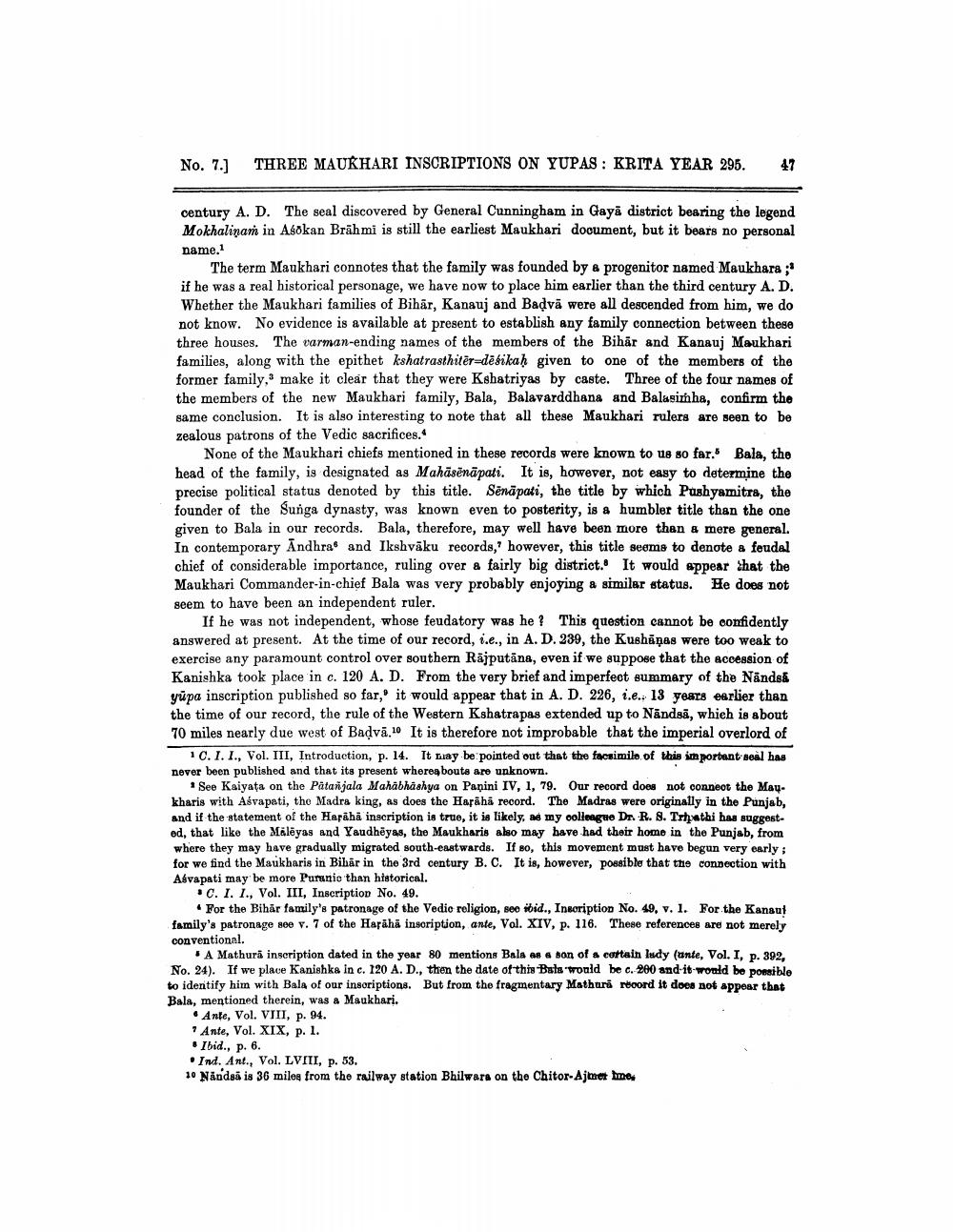________________
No. 7.]
THREE MAUKHARI INSCRIPTIONS ON YUPAS : KRITA YEAR 295.
47
century A. D. The seal discovered by General Cunningham in Gayā district bearing the legend Mokhalinam in Asokan Brāhmi is still the earliest Maukhari document, but it bears no personal name.1
The term Maukhari connotes that the family was founded by a progenitor named Maukhara ;' if he was a real historical personage, we have now to place him earlier than the third century A. D. Whether the Maukhari families of Bihar, Kanauj and Badvā were all descended from him, we do not know. No evidence is available at present to establish any family connection between these three houses. The varman-ending names of the members of the Bihār and Kanauj Maukhari families, along with the epithet kshatrasthitēr=dētikaḥ given to one of the members of the former family, make it clear that they were Kshatriyas by caste. Three of the four names of the members of the new Maukhari family, Bala, Balavarddhana and Balasimha, confirm the same conclusion. It is also interesting to note that all these Maukhari rulers are seen to be zealous patrons of the Vedic sacrifices.
None of the Maukhari chiefs mentioned in these records were known to us so far. Bala, the head of the family, is designated as Mahāsēnāpati. It is, however, not easy to determine the precise political status denoted by this title. Sēnāpati, the title by which Pushyamitra, the founder of the Sunga dynasty, was known even to posterity, is a humbler title than the one given to Bala in our records. Bala, therefore, may well have been more than & mere general. In contemporary Andhra and Ikshvāku records, however, this title seems to denote a feudal chief of considerable importance, ruling over a fairly big district. It would appear that the Maukhari Commander-in-chief Bala was very probably enjoying a similar status. He does not seem to have been an independent ruler.
If he was not independent, whose feudatory was he? This question cannot be confidently answered at present. At the time of our record, i.e., in A. D. 239, the Kushāņas were too weak to exercise any paramount control over southern Rajputāna, even if we suppose that the accession of Kanishka took place in c. 120 A. D. From the very brief and imperfect summary of the Nändsk yüpa inscription published so far, it would appear that in A. D. 226, i.e.. 13 years earlier than the time of our record, the rule of the Western Kshatrapas extended up to Nāndsă, which is about 70 miles nearly due west of Badvā.10 It is therefore not improbable that the imperial overlord of
10.1.1., Vol. III, Introduction, p. 14. It may be pointed out that the facsimile of this important seal has never been published and that its present whereabouts are unknown.
See Kaiyata on the Patañjala Mahabhashya on Paņini IV, 1, 79. Our record does not conneot the May. kharis with Aśvapati, the Madra king, as does the Hapāhā record. The Madras were originally in the Punjab, and if the statement of the Hapāhā inscription is true, it is likely, as my colleague Dr. R. 8. Trpathi has suggested, that like the Mälēyas and Yaudhēyas, the Maukharis also may have had their home in the Punjab, from where they may have gradually migrated south-eastwards. If so, this movement must have begun very early : for we find the Maukharis in Bibār in the 3rd century B. C. It is, however, possible that the connection with Aévapati may be more Puranic than historical.
• C. I. I., Vol. III, Inscription No. 49.
. For the Bihár family's patronage of the Vedic religion, see ibid., Inscription No. 49, v. 1. For the Kanaal family's patronage see v. 7 of the Hapāhā inscription, ante, Vol. XIV, p. 116. These references are not merely conventional
A Mathurā inscription dated in the year 80 mentions Bala as a son of a certain lady (ante, Vol. I, p. 392, No. 24). If we place Kanishka in c. 120 A. D., then the date of this Bats would be c. 200 and-it-would be possible to identify him with Bala of our inscriptions. But from the fragmentary Mathura record it does not appear that Bala, mentioned therein, was a Maukhari.
• Ante, Vol. VIII, p. 94. ? Ante, Vol. XIX, p. 1. • Ibid., p. 6. . Ind. Ant., Vol. LVIII, p. 53. 10 Nandsă is 36 miles from the railway station Bhilwara on the Chitor-Ajmet Imer




